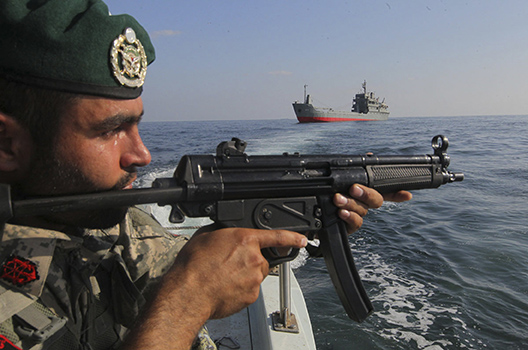 “If they impose sanctions on Iran’s oil exports, then even one drop of oil cannot flow from the Strait of Hormuz.”
“If they impose sanctions on Iran’s oil exports, then even one drop of oil cannot flow from the Strait of Hormuz.”
After a long week of Iran headlines – US Secretary of State Mike Pompeo laying out the administration’s Iran strategy, Presidents Trump and Rouhani trading implicit threats of war, Iranian Revolutionary Guard Corps-Quds Force (IRGC-QF) Commander Qassem Suleimani addressing Trump by name in a speech – one might be forgiven for mistaking the above as a recent quote.
But that threat is actually from 2012, when Iranian Vice President Mohammad Reza Rahimi decried Obama administration oil sanctions in response to Iran’s nuclear program. Iran’s recent threat to close the Strait of Hormuz is not new, but rather a tactic Tehran has turned to again and again to get what it wants.
About one-fifth of the world’s total oil passes through the Strait of Hormuz, and roughly one-third of tanker traffic squeezes through its two-mile wide shipping lane. The US Energy Information Authority estimates that 18.5 million barrels per day cross the strait, and unofficial numbers calculated a total of 17.2 millionin 2017. These staggering figures make clear the importance of stability in the waterway.
So, while IRGC Commander Mohammed Ali Jafari’s promise earlier in July to “make the enemy understand that either everyone can use the Strait of Hormuz or no one [can]” is jarring, it isn’t quite surprising, or even new. That does not mean there is no reason to be concerned, though. Below are several areas to watch should US-Iran tensions escalate around the Strait of Hormuz.
Even higher oil prices?
The reasons the Trump administration would want to keep the strait open are manifold. Uninterrupted shipping through Hormuz means stable oil prices, which in turn contribute to stability in the global economy. Recognizing the importance of the strait, Iran has in the past threatened to close it as a means of pressuring the United States, while the US Fifth Fleet, stationed in Bahrain, views protecting shipping in the strait as one of its primary objectives.
With the threat of US secondary sanctions pushing down Iranian oil exports, oil prices are set to rise in the coming year. To offset this, the Trump administration has pushed Saudi Arabia to increase its production to prevent prices from rocketing upward. The Saudis have duly increased its oil output, though not to the point where they can curb rising prices completely. An earnest Iranian blockade of the strait would therefore drive oil prices up, potentially throwing sand in the gears of the Trump administration’s plans to stabilize prices.
Iran has made this threat multiple times in the past – the United States is prepared for it – and the likelihood of Tehran taking action on this occasion seems low. Blockading the strait would be an escalatory step that would almost certainly elicit an international response led by US maritime forces in the Gulf and cause a military escalation that no party ostensibly wants.
Read the rest on the New Atlanticist blog.
Owen Daniels is an associate director with the Middle East Security Initiative in the Atlantic Council’s Scowcroft Center for Strategy and Security. Follow him on Twitter: @OJDaniels.
Image: A military personnel participates in the Velayat-90 war game on Sea of Oman near the Strait of Hormuz in southern Iran December 28, 2011. (REUTERS/Fars News/Hamed Jafarnejad)
